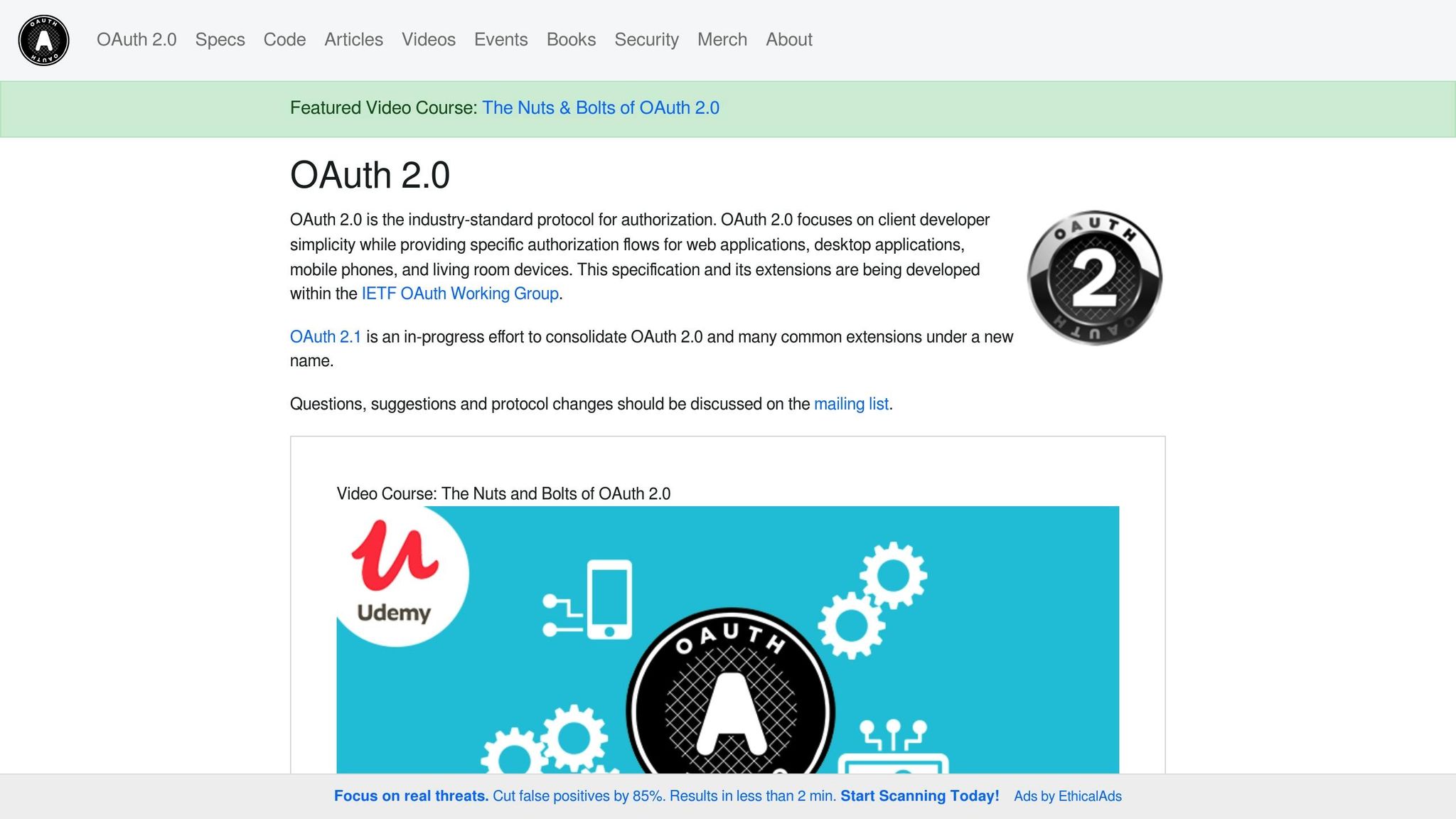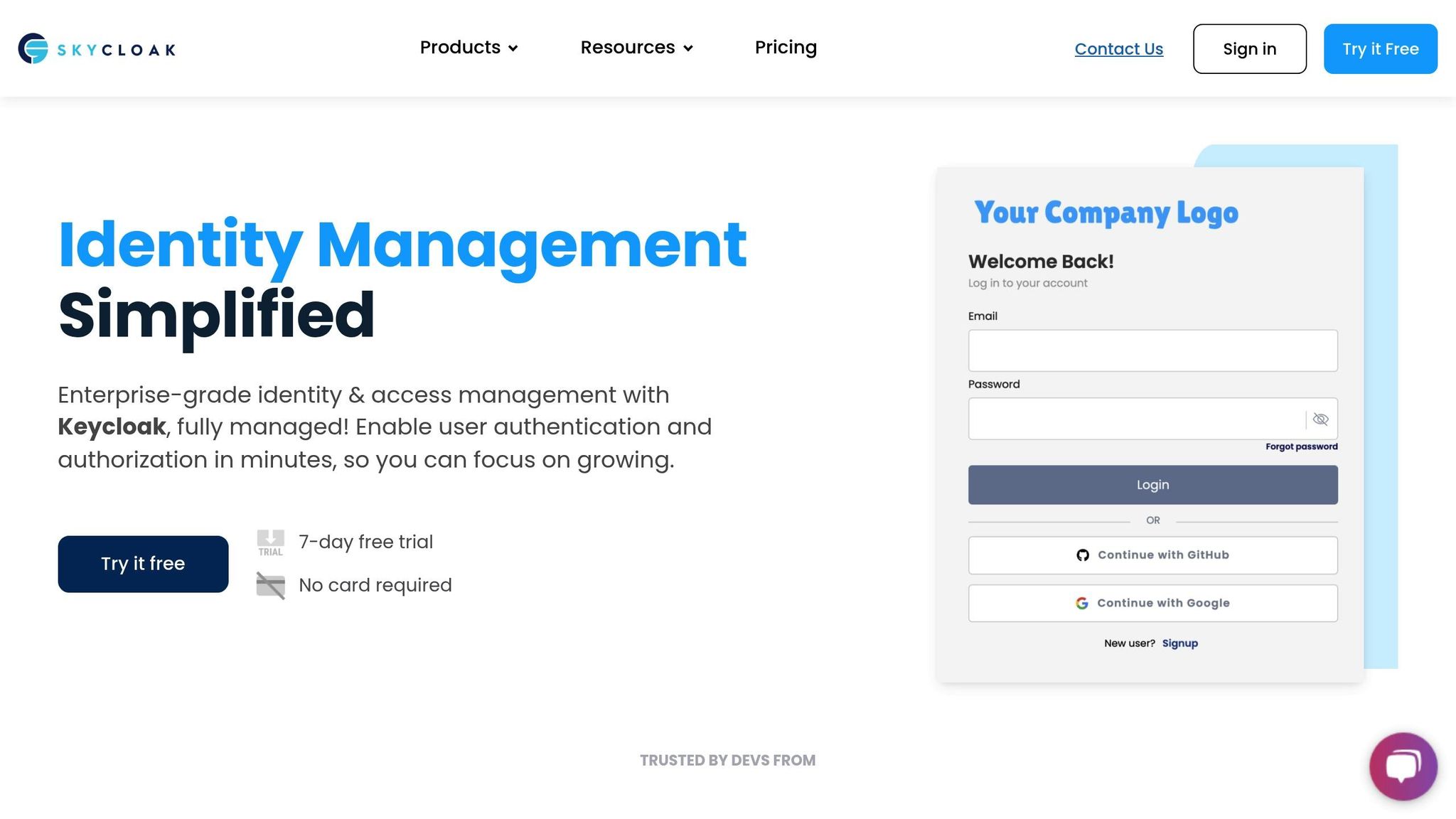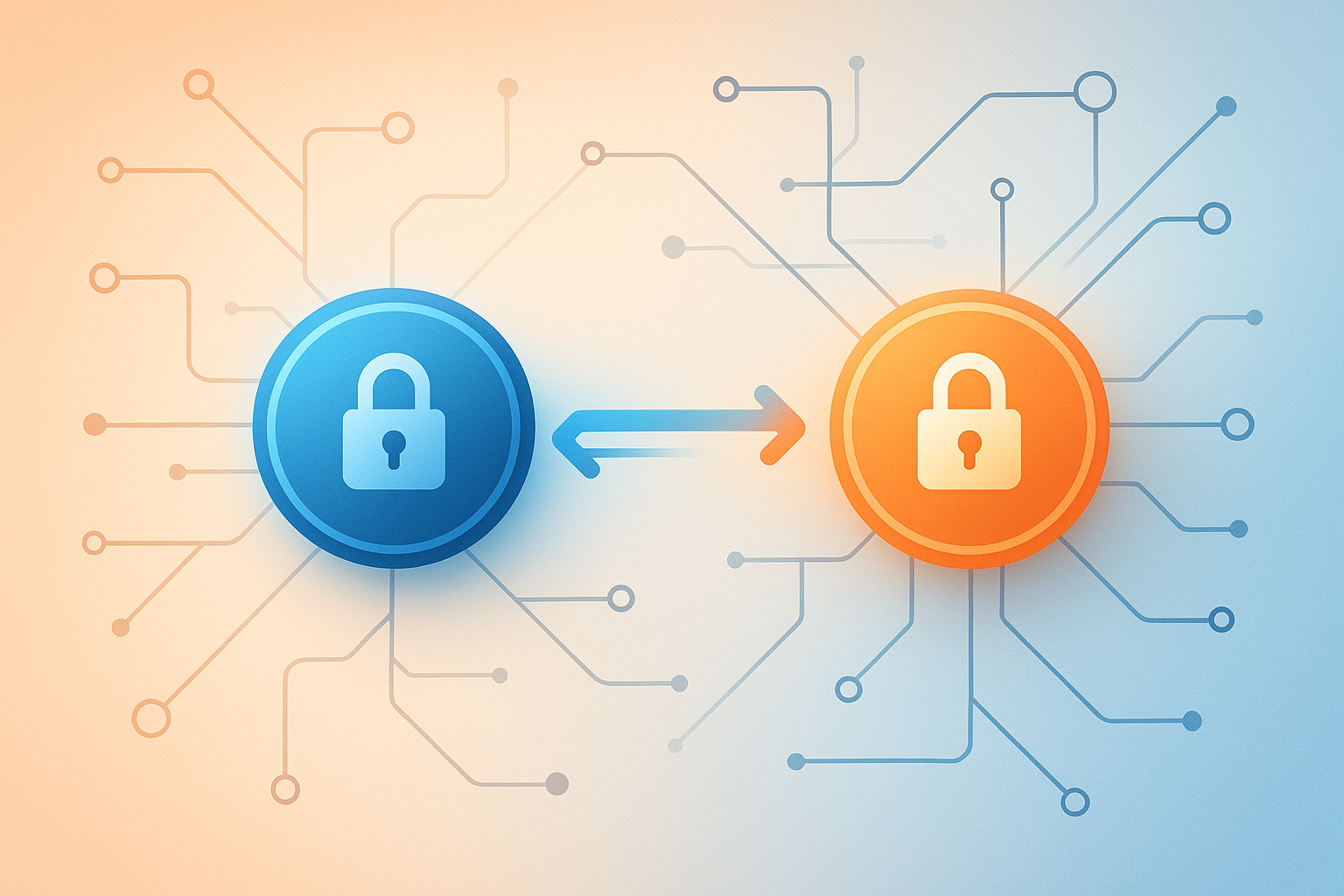Keycloak‘s token exchange lets you securely swap tokens to fit specific services or tasks. It’s perfect for microservices, cross-domain access, and delegation scenarios. Here’s how it works:
- What it does: Converts one token into another with tailored permissions.
- Why it’s useful: Ensures secure communication between services, supports delegation, and simplifies cross-domain authentication.
- Who’s involved: The resource owner (original token holder), client application (requester), and Keycloak server (token issuer).
Quick Overview:
- Token Types: Subject (original), Actor (initiator), Target (new).
- Steps: Validate request → Check policies → Issue new token.
- Use Cases: Service-to-service access, cross-domain authentication, delegation.
For enterprises, tools like Skycloak enhance Keycloak by automating setup, ensuring high availability, and adding advanced security features.
OAuth 2.0 – Token Exchange

Token Exchange Components
Keycloak’s token exchange process securely transforms and delegates tokens, ensuring security policies are followed while enabling effective delegation.
Main Functions
Keycloak’s token exchange serves two primary purposes:
- Identity Translation: Converts tokens between different identity formats while maintaining their security context.
- Scope Adjustment: Alters token permissions to meet the specific needs of a service.
This functionality supports a variety of deployment scenarios.
Key Participants
Three key players are involved in the token exchange process:
| Participant | Role | Responsibilities |
|---|---|---|
| Resource Owner | Token Subject | Holds the original credentials and provides access permissions. |
| Client Application | Requester | Initiates the exchange request and uses the newly issued token. |
| Keycloak Server | Token Issuer | Validates requests, performs the exchange, and issues new tokens. |
The Keycloak server serves as the central authority, managing the process and ensuring that roles, permissions, and other security policies are applied correctly.
Implementation Examples
Here are some practical ways token exchange is used:
- Service-to-Service Communication
In microservice setups, one service often needs to securely access another. Token exchange allows a service to obtain a token with just the right permissions, ensuring minimal access while maintaining security. - Cross-Domain Authentication
This process makes secure authentication across different domains possible, without compromising security standards. - Delegation Scenarios
For example, a payment service can request a token with limited permissions to perform specific actions on behalf of a user, ensuring tasks are carried out securely and efficiently.
How Token Exchange Works
Keycloak’s token exchange process involves five main steps:
- Initial Request Preparation
The client sets up the request with key parameters, such as:
- The token to be exchanged (source token)
- The type of token being requested
- The target audience or resource
- Any additional scope requirements
- Authentication Validation
Keycloak checks the token’s signature, expiration time, client permissions, and audience restrictions to ensure everything is valid.
- Policy Evaluation
The server reviews exchange policies, including:
- Permissions for token exchange
- Role mappings
- Scope restrictions
- Audience limitations
- Token Generation
Once validation is complete, Keycloak:
- Issues a new token with updated claims
- Adjusts the scope as requested
- Sets expiration details
- Signs the token using its private key
- Response Delivery
The server sends back a response containing the new token or an error message explaining why the exchange failed.
Request and Response Examples
Here’s an example of a token exchange request:
POST /auth/realms/master/protocol/openid-connect/token HTTP/1.1
Content-Type: application/x-www-form-urlencoded
grant_type=urn:ietf:params:oauth:grant-type:token-exchange
&client_id=my-client
&client_secret=secret123
&subject_token=eyJhbGciOiJSUzI1...
&requested_token_type=urn:ietf:params:oauth:token-type:refresh_token
&audience=target-service
A successful response might look like this:
{
"access_token": "eyJhbGciOiJSUzI1...",
"expires_in": 300,
"refresh_token": "eyJhbGciOiJSUzI1...",
"token_type": "Bearer",
"issued_token_type": "urn:ietf:params:oauth:token-type:refresh_token"
}
Security Parameters
Below is a breakdown of the key security parameters for token exchange:
| Parameter | Description | Required |
|---|---|---|
| grant_type | Must be set to the token exchange URI | Yes |
| subject_token | The token being exchanged | Yes |
| requested_token_type | Type of token being requested | No |
| audience | Target service for the new token | No |
| scope | Requested scope for the new token | No |
sbb-itb-9d854a3
Types of Token Exchange
Keycloak provides several token exchange patterns tailored to different identity and access management (IAM) needs.
Internal Token Exchange
This occurs within the same Keycloak realm, allowing microservices to exchange tokens with adjusted permissions. Key features include:
- Service-to-service communication: Tokens are customized for specific audiences.
- Permission refinement: Downstream services receive tokens with reduced scopes.
- Audience targeting: Tokens are designed for specific service endpoints.
This approach serves as a foundation for more advanced exchanges, such as external token conversions or delegation.
External Token Exchange
Through external token exchange, Keycloak transforms tokens from external identity providers into Keycloak-compatible tokens. This process facilitates:
- Integration with social login providers.
- Enterprise SSO system compatibility using tokens like SAML or JWT.
- Cross-realm federation to unify authentication across systems.
Impersonation and Delegation
This pattern allows authorized services to act on behalf of users or other services. Key considerations include:
- Authority checks: Ensuring proper permissions for impersonation or delegation.
- Enhanced security: Auditing actions and limiting token scopes.
- Time-limited tokens: Tokens are issued with expiration for specific tasks.
These patterns help manage complex authentication and authorization scenarios effectively.
Token Exchange with Skycloak

Skycloak builds on Keycloak’s token exchange system, making it faster to deploy and more secure. By automating configurations, Skycloak simplifies the process while maintaining the core security and efficiency of Keycloak’s token exchange.
Simplified Setup Tools
Skycloak offers tools to make configuring token exchange quick and straightforward:
- Docker-compose Generator: Creates container configurations tailored for token exchange.
- Pre-configured Templates: Ready-made setups for common scenarios.
- Interactive Configuration: Step-by-step guides for customizing exchange parameters.
These tools help teams get token exchange up and running in just a few minutes.
Expanded IAM Capabilities
Skycloak enhances Keycloak’s token exchange functionality with additional features:
| Feature | Function | Benefit |
|---|---|---|
| Cluster Management | Automates setup and scaling of Keycloak clusters | Ensures reliable performance |
| Framework Integration | Includes connectors for popular development tools | Simplifies integration processes |
| Custom Extensions | Supports specialized plugins for token exchange | Adapts to specific use cases |
The platform also provides real-time insights into token exchange operations, ensuring both security and performance are upheld.
Tailored for Enterprise
Skycloak is designed to meet the needs of enterprise users by offering reliability, advanced security, and dedicated support.
1. High Availability Configuration
Skycloak enables distributed token exchange across multiple Keycloak clusters, with an impressive 99.995% SLA for enterprise clients.
2. Enhanced Security Features
Enterprise deployments include:
- Secure private network access.
- Full monitoring capabilities.
- Support for custom domains.
- Compliance with GDPR and SOC2 standards.
3. Dedicated Support
Enterprise users gain access to 24/7 premium support, plus two hours of expert consulting each month.
Conclusion
Keycloak’s token exchange simplifies secure authentication and authorization processes. It allows organizations to handle both complex B2B scenarios involving multiple organizations and large-scale B2C environments with millions of users seamlessly.
With the components and workflows for token exchange already outlined, managed services now make deployment and maintenance far easier. For example, Skycloak’s managed service eliminates the challenges of self-hosting. Automated setups replace lengthy, manual configurations, enabling enterprise-level deployments in a fraction of the time.
Here’s a comparison of key aspects between self-managed and managed token exchange solutions:
| Aspect | Self-Managed | Managed |
|---|---|---|
| Deployment Time | Days to weeks | Minutes to hours |
| Security Compliance | Manual configuration | Automated GDPR & SOC2 |
| Scalability | Limited by infrastructure | Elastic with 99.995% SLA |
| Maintenance | Resource-intensive | Fully managed |
As the demand for robust Identity and Access Management (IAM) solutions grows, efficient token exchange mechanisms have become a top priority. Skycloak’s managed approach showcases how automation can drastically reduce the complexity of managing IAM infrastructure, all while maintaining strict security standards. These advancements highlight the importance of continuously improving IAM solutions.
FAQs
How does Keycloak securely handle token exchanges between services?
Keycloak ensures secure token exchanges by implementing robust authentication and authorization protocols. It verifies the identity of the requesting service and enforces strict access controls to prevent unauthorized access.
Additionally, token exchanges are protected using secure communication channels, such as HTTPS, to safeguard sensitive data during transmission. These measures ensure that only trusted services can exchange tokens within a Keycloak-managed environment.
What challenges might arise when implementing Keycloak’s token exchange in large-scale enterprise systems?
Implementing Keycloak’s token exchange in a large-scale enterprise environment can present several challenges. Scalability is often a key concern, as the system must handle a high volume of token exchanges without compromising performance or reliability. Proper infrastructure planning and load testing are crucial to ensure smooth operations.
Another challenge is security configuration. Token exchange involves sensitive data, so misconfigurations or insufficient access controls could lead to vulnerabilities. It’s essential to define strict policies and permissions to prevent unauthorized access or misuse.
Lastly, integration complexity can be an issue, especially when connecting multiple applications, APIs, or third-party systems. Ensuring seamless communication between all components may require significant effort and expertise. Leveraging managed IAM services like Skycloak can simplify these processes by automating configurations and providing pre-built solutions tailored to enterprise needs.
What is the difference between internal and external token exchange in Keycloak, and when should you use each?
In Keycloak, internal token exchange refers to exchanging tokens within the same Keycloak realm or between realms in the same Keycloak instance. This is typically used when managing access within a unified system or organization. On the other hand, external token exchange involves exchanging tokens with external systems or identity providers, enabling seamless integration across different platforms or services.
You should use internal token exchange when handling user authentication or authorization within your Keycloak-managed environment. External token exchange is ideal when integrating with third-party services or bridging multiple identity systems. Both methods ensure secure and efficient token handling, tailored to your specific use case.

